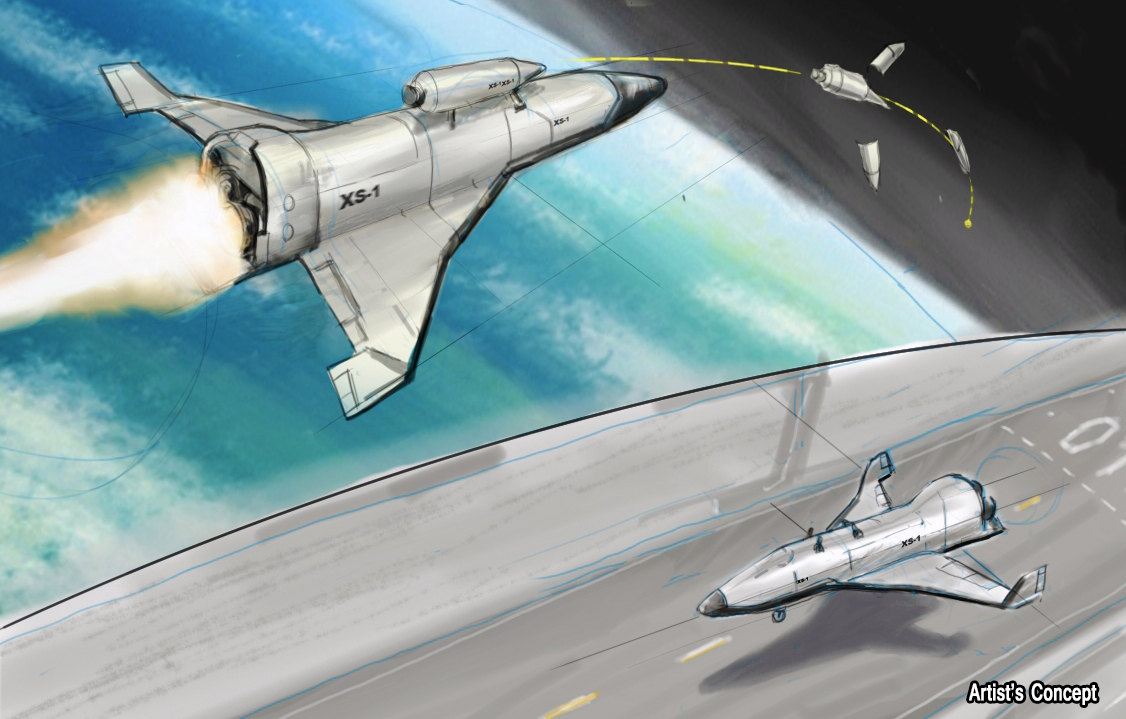An experimental spaceplane with ‘aircraft-like’ operations in orbit
September 19, 2013

DARPA’s new Experimental Spaceplane (XS-1), a reusable hypersonic unmanned vehicle (credit: DARPA)
Imagine a fully reusable unmanned vehicle that would provide rapid, aircraft-like access to space. It would operate from a “clean pad” with a small ground crew and no need for expensive specialized infrastructure. It would enable routine daily operations and flights from a wide range of locations. And it would deploy small satellites faster and more affordably, while demonstrating technology for next-generation space and hypersonic flight for both government and commercial users.
Introducing DARPA‘s new Experimental Spaceplane (XS-1) program.
“We want to build off of proven technologies to create a reliable, cost-effective space delivery system with one-day turnaround,” said Jess Sponable, DARPA program manager heading XS-1. “How it’s configured, how it gets up and how it gets back are pretty much all on the table—we’re looking for the most creative yet practical solutions possible.”
DARPA seeks ideas and proposals
DARPA seeks ideas and technical proposals for how to best develop and implement the XS-1 program. The agency has scheduled an XS-1 Proposers’ Day for Monday, October 7, 2013. The agency also plans to hold 1-on-1 discussions with potential proposers on the following day, October 8, 2013. Advance registration is required; more information is available at http://www.sa-meetings.com/XS1ProposersDay. Registration closes on Tuesday, October 1,2013, at 12:00 PM EDT. For more information, please email DARPA-SN-14-01@darpa.mil.
The DARPA Special Notice describing the specific capabilities the program seeks is available at http://go.usa.gov/DNkF. A Broad Agency Announcement (BAA) for XS-1 is forthcoming and will be posted on the Federal Business Opportunities website.
How it would work
- Reusable first stage flies to hypersonic speeds at a suborbital altitude.
- At that point, one or more expendable upper stages separate and deploy a satellite into Low Earth Orbit.
- The reusable hypersonic aircraft then returns to earth, lands and is prepared for the next flight.
Key XS-1 technical goals include flying 10 times in 10 days, achieving speeds of Mach 10+ at least once and launching a representative payload to orbit. The program also seeks to reduce the cost of access to space for small (3,000- to 5,000-pound) payloads by at least a factor of 10, to less than $5 million per flight.
XS-1 would complement a current DARPA program already researching satellite launch systems that aim to be faster, more convenient and more affordable: Airborne Launch Assist Space Access (ALASA). ALASA seeks to propel 100-pound satellites into orbit for less than $1 million per launch using low-cost, expendable upper stages launched from conventional aircraft.
“XS-1 aims to help break the cycle of launches happening farther and farther apart and costing more and more,” Sponable said. “It would also help further our progress toward practical hypersonic aircraft technologies and increase opportunities to test new satellite technologies as well.”
(¯`*• Global Source and/or more resources at http://goo.gl/zvSV7 │ www.Future-Observatory.blogspot.com and on LinkeIn Group's "Becoming Aware of the Futures" at http://goo.gl/8qKBbK │ @SciCzar │ Point of Contact: www.linkedin.com/in/AndresAgostini
 Washington
Washington